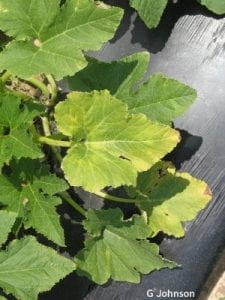Gordon Johnson, Extension Vegetable & Fruit Specialist; gcjohn@udel.edu
With the hot, humid weather, we are starting to see evidence of air pollution damage in sensitive vegetable plants.
Vegetables most susceptible to air pollution include potatoes, watermelons, cantaloupes, snap beans, pumpkins, and squash.
Damage is most common during hot, humid, hazy weather with little wind. Air inversions, when warm air at the surface is trapped by even hotter air in the atmosphere above, lead to build up of air pollutants that cannot disperse and, consequently, plant injury. The most common form of air pollution injury to plants is ozone damage. Ozone is a strong oxidant and is formed by the action of sunlight on products of fuel combustion. It is moved from areas of high concentration (cities, heavy traffic areas) to nearby fields.
Ozone injury in susceptible vegetable varieties develops when ozone levels are over 80 ppb for four or five consecutive hours, or 70 ppb for a day or two when vegetable foliage at a susceptible stage of growth. Because it occurs in areas with high levels of automobile exhausts, crop injury is often visible on fields in close proximity to roads, especially with heavy summer weekend traffic. High pollution indexes in Baltimore and Washington are also a good indication that ozone damage may occur.
In potatoes, symptoms of ozone damage occur on the most recently emerged leaves and can be seen as a black flecking. Early red varieties are most susceptible.
Injury on watermelon leaves consists of premature chlorosis (yellowing) on older leaves. Leaves subsequently develop brown or black spots with white patches. Watermelons are generally more susceptible than other cucurbits to ozone damage. Damage is more prevalent when fruits are maturing or when plants are under stress. Injury is seen on crown leaves first and then progresses outward. Seedless watermelon varieties tend to be more resistant to air pollution injury than seeded varieties, so injury often shows up on the pollenizer plants first. “ice box” types are the most susceptible.
In muskmelons and other melons, the upper surface of leaves goes directly from yellow to a bleached white appearance.
Ozone injury on squash is intermediate between watermelon and cantaloupe starting with yellowing of older interior or crown leaves. These leaves subsequently turn a bleached white color with veins often remaining green.
In snap and lima beans, ozone causes small bleached spots, giving a bronze appearance on upper leaf surfaces and pods. Leaves may ultimately turn chlorotic and senesce (drop).
Ozone injury can be easily misdiagnosed as mite injury, pesticide phytotoxicity, or deficiencies.
The key to avoiding air pollution injury is to plant varieties that are of low susceptibility and to limit plant stresses. Certain fungicides such as thiophanate methyl (Topsin and others) offer some protection against ozone damage.


